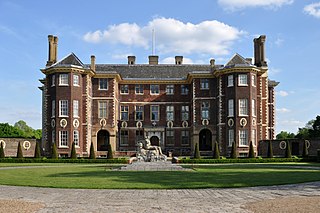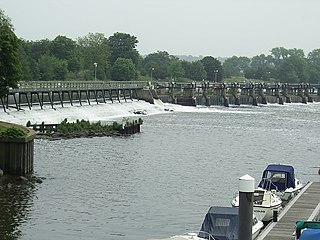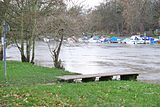
Petersham is a village in the London Borough of Richmond upon Thames on the east of the bend in the River Thames south of Richmond, which it shares with neighbouring Ham. It provides the foreground of the scenic view from Richmond Hill across Petersham Meadows, with Ham House further along the river. Other nearby places include Twickenham, Isleworth, Teddington, Mortlake and Roehampton.

Twickenham, in southwest London, England, is on the River Thames 9.9 miles (15.9 km) southwest of Charing Cross, 2 miles (3.2 km) southeast of Hounslow, and 2.6 miles (4.2 km) northwest of Kingston upon Thames.

The London Borough of Richmond upon Thames in southwest London forms part of Outer London and is the only London borough on both sides of the River Thames. It was created in 1965 when three smaller council areas amalgamated under the London Government Act 1963. It is governed by Richmond upon Thames London Borough Council and is divided into nineteen wards. The population is 198,019 and the major settlements are Barnes, East Sheen, Mortlake, Richmond, Twickenham, Teddington and Hampton.
Richmond is a town in south-west London, 8.2 miles (13.2 km) west-southwest of Charing Cross. It is on a meander of the River Thames, with many parks and open spaces, including Richmond Park, and many protected conservation areas, which include much of Richmond Hill. A specific Act of Parliament protects the scenic view of the River Thames from Richmond.

Eel Pie Island is an 8.935-acre (3.6 ha) island in the River Thames at Twickenham in the London Borough of Richmond upon Thames. It is on the maintained minimum head of water above the only lock on the Tideway and is accessible by boat or from the left bank by footbridge. The island had a club that was a major venue for jazz and blues in the 1960s.

Pie and mash is a traditional working-class food, originating in the Docks of London. It typically consists of a minced beef pie, mashed potato and a parsley sauce known as liquor. Pie, mash and eel shops have been in London since the 19th century, and are still common in East and South London, and in many parts of Kent and Essex. The shops may also serve stewed or jellied eels.

St Margarets is a suburb in the London Borough of Richmond upon Thames, about 9 miles (14 km) west-southwest of central London. It is bounded by the Thames Tideway to the north-east, and the River Crane to the north-west and north where the land tapers between these rivers. The place does not extend any further south than Richmond Road, Twickenham. Land and buildings closer to Richmond Bridge than the eponymous railway station are, traditionally distinctly, known as East Twickenham. Both places go by their post town and traditional parish, Twickenham quite often; in the 19th century the south of St Margarets was marked on maps as Twickenham Park.

Ham House is a 17th-century house set in formal gardens on the bank of the River Thames in Ham, south of Richmond in the London Borough of Richmond upon Thames. The original house was completed in 1610 by Thomas Vavasour, an Elizabethan courtier and Knight Marshal to James I. It was then leased, and later bought, by William Murray, a close friend and supporter of Charles I. The English Civil War saw the house and much of the estate sequestrated but Murray's wife Katherine regained them on payment of a fine. During the Protectorate, his daughter Elizabeth, Countess of Dysart on her father’s death in 1655, successfully navigated the prevailing anti-royalist sentiment and retained control of the estate.

Twickenham Rowing Club was founded on 26 July 1860 so is jointly with Thames Rowing Club the third oldest rowing club on the Thames. The club is on Eel Pie Island in Twickenham, south-west London. Its boat code is TWK.

Eel Pie Recording Studios, formerly Oceanic, was a recording studio located in The Boathouse, Twickenham on the banks of the River Thames in Ranelagh Drive, by Twickenham Bridge, West London, and also simultaneously at No. 45 Broadwick Street, Soho, London. The name for the studios came from the nearby Eel Pie Island, which was known as a major jazz and blues venue in the 1960s.

Ham is a suburban district in Richmond, south-west London. It has meadows adjoining the River Thames where the Thames Path National Trail also runs. Most of Ham is in the London Borough of Richmond upon Thames and, chiefly, within the ward of Ham, Petersham and Richmond Riverside; the rest is in the Royal Borough of Kingston upon Thames. The district has modest convenience shops and amenities, including a petrol station and several pubs, but its commerce is subsidiary to the nearby regional-level economic centre of Kingston upon Thames.
Richmond Bridge is an 18th-century stone arch bridge that crosses the River Thames at Richmond, connecting the two halves of the present-day London Borough of Richmond upon Thames. It was designed by James Paine and Kenton Couse.

The Tideway is a part of the River Thames in England which is subject to tides. This stretch of water is downstream from Teddington Lock. The Tideway comprises the upper Thames Estuary including the Pool of London.

William John Manners Tollemache, 9th Earl of Dysart DL in the Peerage of Scotland, was also a Baronet (cr.1793) in the Baronetage of Great Britain, Lord Lieutenant of Rutland (1881–1906), and Justice of the Peace for Leicestershire and Lincolnshire.

The Twickenham Ferry, sometimes known as Dysart's Ferry, was a historic ferry crossing of the River Thames in what is now the London Borough of Richmond upon Thames, England. The ferry connected a location just downstream to Eel Pie Island in the town of Twickenham on the northern bank of the river with Ham House on the southern bank. It should not be confused with today's Hammerton's Ferry, which crosses the river some distance downstream of the route of the Twickenham Ferry.

The Boathouse is a commercial property located at Ranelagh Drive, Twickenham in England, which housed music and film studios.

Canbury is a district of the northern part of Kingston upon Thames that takes its name from the historic manor that covered the area. Modern Canbury comprises two electoral wards in the constituency of Richmond Park; Canbury Ward to the south and Tudor Ward to the north.

Ham Common is an area of common land in Ham, London. It is a conservation area in, and managed by, the London Borough of Richmond upon Thames. It comprises 48.69 hectares, the second largest area of common land in the borough, 2 acres (0.81 ha) smaller than Barnes Common. It is divided into two distinct habitats, grassland and woodland, separated by the A307, Upper Ham Road. It is an area of ecological, historical and recreational interest, designated a Local Nature Reserve.

Latchmere Recreation Ground is a public open space with playing fields and a children's playground in the north of the Royal Borough of Kingston upon Thames.






















